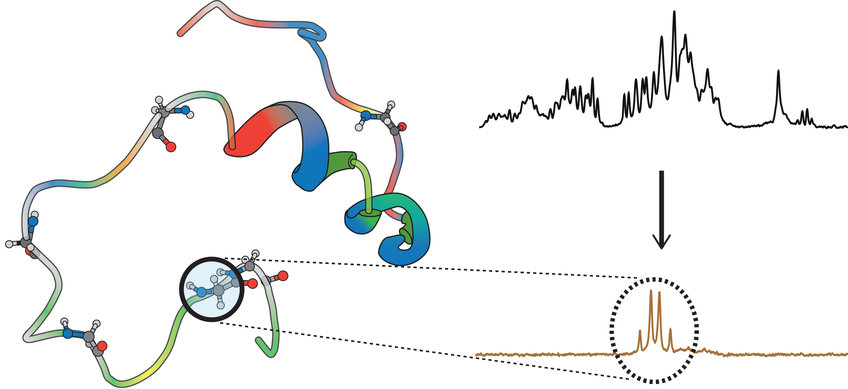New NMR method facilitates investigation of specific parts of molecules while reducing background signals
Nuclear magnetic resonance (short: NMR) has a massive impact on our today’s world. MRI, for example, is based on this technology: It is used by clinics and doctor’s practices worldwide to take millions of magnetic resonance images every year to identify and investigate diseases or to monitor the progress of therapies. NMR is also one of the standard methods for examining proteins and other molecules in atomic resolution: What is the three-dimensional structure of proteins in the cell and how do they carry out their job? How do they interact with each other or with a drug?
The NMR method makes use of the fact that many atomic nuclei have magnetic properties, the so-called nuclear spin. This spin behaves like a small bar magnet: When the atomic nucleus enters a magnetic field, the spin orients itself along this field. The spins are rotated by radio wave irradiation and return to their original state when the radio waves are switched off. In doing so, the spins emit electromagnetic signals that are strongly dependent on their environment. By detecting these signals, researchers can obtain important information about the structure and dynamics of molecules they investigate.
Background signals reduced
One problem with this is technique is, however, that scientists not only receive signals of the desired molecular structure or chemical group, but also a lot of background signals from other proteins in the environment or the omnipresent water. This is where the new method comes into play, which is being published in the current issue of the journal Science Advances with first author Salvatore Mamone. “This method allows us to switch the signals of individual protein building blocks or metabolic products specifically on or off,” Glöggler summarizes.
To make this work, Glöggler's team uses a sophisticated trick: “For our switch we exploit the fact that many molecules contain several hydrogen atoms. These behave like compass needles that always point north – the typical state that is detected by nuclear spin,” explains the research group leader,“ and two hydrogen atoms can couple with each other via chemical bonds. If we then rotate one of these compass needles so that it points south, while the other remains pointing north, we create a protected state invisible to the nuclear spin detector,” the chemist continues. The researchers create this protected state by arbitrarily coupling spins exactly in the part of the molecule they want to study. In the next step, all other, unprotected background signals are suppressed. Now the protected spins only need to be returned to their normal state and the scientists can then detect the desired signals – without any overlap.

Filtered NMR signal of one amino acid in the Aβ40 peptide which is connected to Alzheimer’s disease.
Investigation of very slow dynamic processes
The protected state has another major advantage: The spin pointing south swings back north slowly. Therefore, with the new method, researchers can investigate very slow dynamic processes better than with conventional nuclear spin methods.
The Max Planck researcher also plans to use the technique in the future to better understand disease-related protein aggregations. Such deposits can be found in the brains of patients suffering from neurodegenerative diseases such as Alzheimer's and Parkinson's. In addition, the new NMR method can be applied to elucidate how active compounds interact with their target molecules.
The Göttingen scientists also want to make the method directly usable for MRI so that patients can benefit from it. “In particular, we want to analyze metabolic products directly in the tissue to examine the changes in metabolism during diseases in more detail. We hope that such findings can also be applied in medical diagnostics,” the research group leader says. (sg/cr)









![[Fe]-hydrogenase catalysis visualized using para-hydrogen-enhanced nuclear magnetic resonance spectroscopy](/4868136/teaser-1734084319.jpg?t=eyJ3aWR0aCI6MzYwLCJoZWlnaHQiOjI0MCwiZml0IjoiY3JvcCIsImZpbGVfZXh0ZW5zaW9uIjoianBnIiwib2JqX2lkIjo0ODY4MTM2fQ%3D%3D--0262c0fa020d6ea4060dd5aacac2a1dcdee31120)


